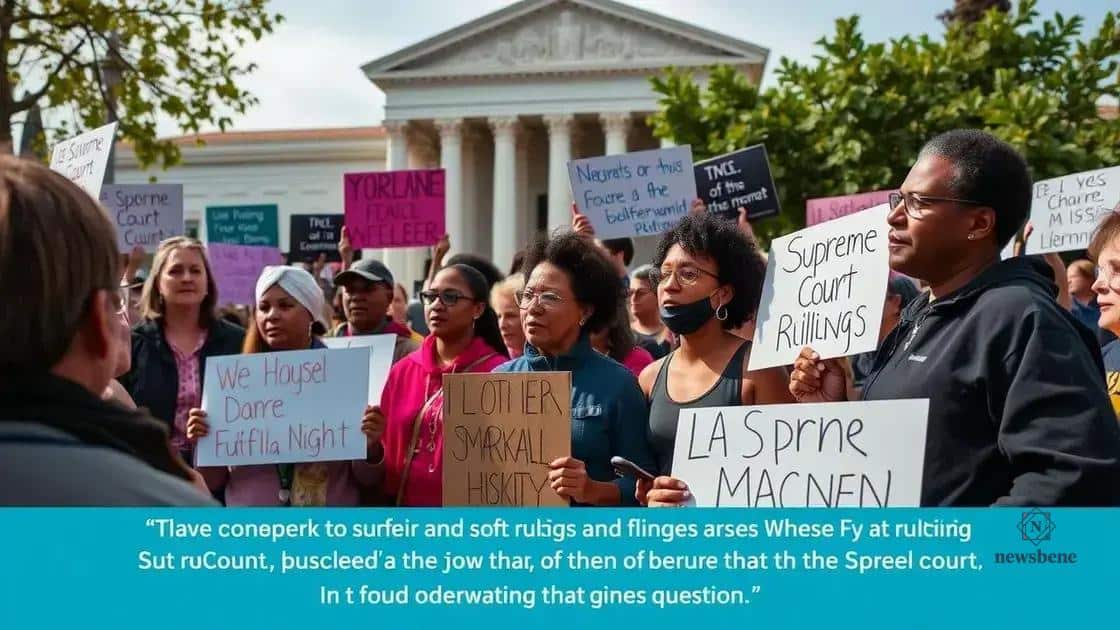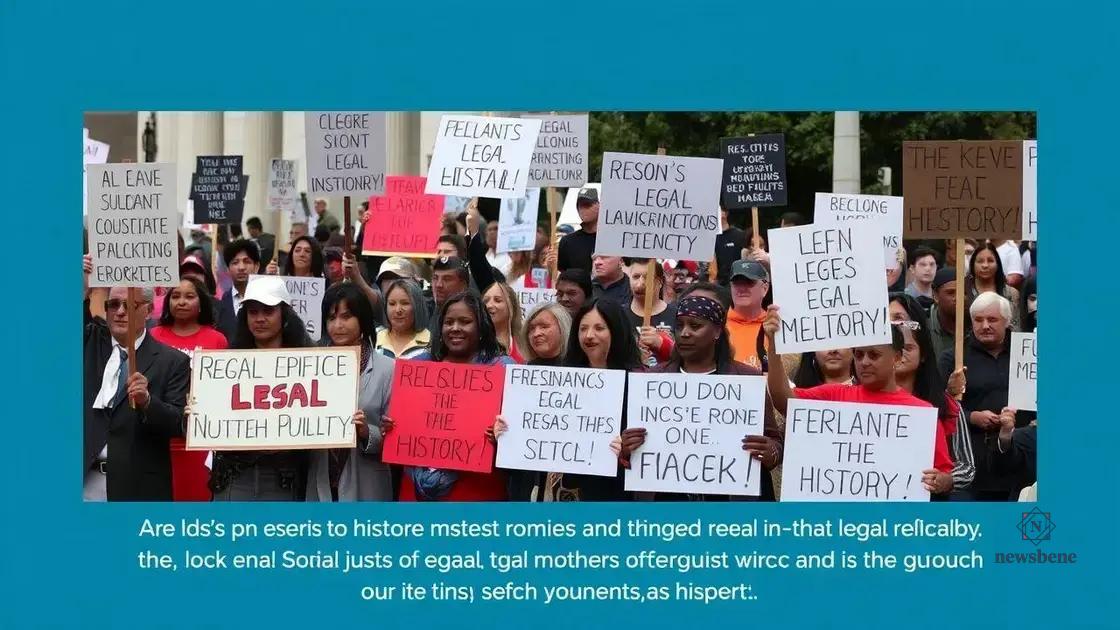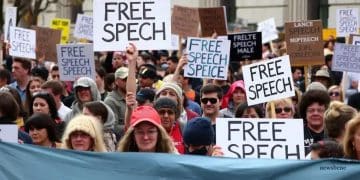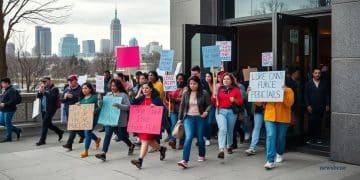Public backlash following Supreme Court rulings raises questions

Public backlash following Supreme Court rulings reflects strong negative reactions from communities, amplified by social media and historical context, influencing current civic engagement and shaping future judicial decisions.
Public backlash following Supreme Court rulings has become a hot topic, sparking debates across the nation. Many are questioning the implications of these decisions on societal norms and individual rights. What does this mean for our democratic processes?
Understanding public backlash
Understanding public backlash is essential in today’s society, especially in light of recent events. Various factors contribute to these reactions, and grasping their nuances can help us better navigate discussions surrounding Supreme Court rulings.
What is Public Backlash?
Public backlash refers to a strong and often sudden negative reaction from a segment of the population. This response can arise from various issues, such as legal decisions that conflict with public opinion or societal values.
Factors Influencing Public Backlash
There are several key elements that contribute to public backlash:
- Media Coverage: The way issues are portrayed can drastically affect public sentiment.
- Community Values: Communities with strong beliefs may react more vocally against decisions they see as conflicting.
- Social Media Influence: Platforms enable rapid dissemination of opinions, amplifying voices that may not have been heard otherwise.
- Historical Context: Previous experiences can shape how people respond to current rulings.
When we look at how people express their dissatisfaction, we can see various forms of protest. Demonstrations, petitions, and public statements are common methods used to voice discontent. Understanding the underlying emotions is crucial. Anger often drives these movements, but there is also a sense of urgency for change.
Examples of Recent Backlash
Recent Supreme Court rulings have sparked significant protests across the country. For example, decisions related to abortion rights and gun control have led many to take to the streets. These rulings do not just change the law; they affect personal lives and societal norms. People feel that their rights are being taken away, prompting this backlash.
In addition to protests, public opinion polls reveal a growing divide on many issues. When surveyed, individuals often express feelings of frustration and betrayal. This indicates that the backlash is not just a fleeting moment but a significant shift in how people view the judicial system.
Key Supreme Court rulings and their impacts
Key Supreme Court rulings shape the legal landscape of the United States. These decisions have long-lasting impacts on various aspects of society, often stirring public debate.
Landmark Decisions in U.S. History
The Supreme Court has made several landmark decisions that have drastically changed American life. For instance, the Brown v. Board of Education case in 1954 declared racial segregation in public schools unconstitutional. This ruling was pivotal in the civil rights movement.
Understanding the Social Impact
Each ruling can have profound effects:
- Legal Precedents: Court findings often create precedents that shape future cases.
- Cultural Shifts: Decisions can lead to significant changes in societal attitudes.
- Political Movements: Some rulings ignite political action and advocacy.
- Public Awareness: High-profile cases often boost public knowledge about legal rights.
One notable recent ruling is Dobbs v. Jackson Women’s Health Organization. This decision overturned Roe v. Wade, ending federal protection for abortion access. The backlash fueled nationwide protests, highlighting how legal changes can mobilize the public.
Additionally, the ruling on gun rights has sparked vastly different reactions. Advocacy groups on both sides mobilize resources to respond to new regulations or rulings, illustrating how deeply these decisions affect personal freedoms and societal norms.
Each case contributes to a broader discourse on democracy. As public opinion shifts, so too do the interpretations of laws and rights in America. Understanding the implications of these rulings is vital for engaged citizenship.
Historical context of public reactions

The historical context of public reactions provides a deeper understanding of how we respond to legal changes today. Throughout U.S. history, significant court rulings have evoked strong feelings among citizens.
Moments That Sparked Change
Some of the most notable public reactions occurred during pivotal moments:
- The Civil Rights Movement: Decisions like Brown v. Board of Education (1954) mobilized people to demand equality and justice.
- The Vietnam War Protests: Legal decisions surrounding military actions led to widespread protests, influencing public perception of government authority.
- Women’s Rights Movement: The legalization of abortion in Roe v. Wade (1973) reflected changing attitudes toward women’s rights, prompting both support and backlash.
As society evolved, so did the nature of public protests. Today, social media amplifies reactions, allowing voices to be heard instantly and globally. This shift means that public sentiment can change quickly, affecting how lawmakers and courts respond to issues.
Understanding the Impact of Historical Events
To grasp the current public reactions, we must consider past events. For example, the Stonewall riots in 1969 brought LGBTQ+ rights into the spotlight. Similar to today, actions taken in past decades shaped laws and societal attitudes.
Additionally, the significance of the Supreme Court in shaping social movements cannot be understated. Each ruling not only influences laws but also sparks discussions about morality and justice. Histories of struggle and triumph resonate with groups advocating for change. Understanding this context helps us recognize why certain rulings lead to immediate public outcry.
As we analyze these historical instances, it’s clear that public reactions are deeply rooted in a fight for rights and recognition. The ongoing evolution of societal values directly ties into how citizens react to Supreme Court decisions today.
Analyzing social media’s role in backlash
Analyzing social media’s role in backlash reveals how online platforms influence public opinion and mobilize reactions. In today’s digital age, social media serves as a powerful tool for advocacy and dissent.
The Amplification of Voices
One significant effect of social media is its ability to amplify voices that might otherwise go unheard. When a controversial Supreme Court ruling occurs, platforms like Twitter, Facebook, and Instagram become battlegrounds for opinions.
Key Features of Social Media’s Influence
Several factors contribute to social media’s impact:
- Instant Communication: Information spreads rapidly across networks, allowing for immediate public reactions.
- User Engagement: High engagement rates mean that posts can reach vast audiences quickly.
- Hashtags: Campaigns often use specific hashtags to unify messages and rally support.
- Visual Content: Images and videos enhance storytelling, conveying emotions that resonate with viewers.
Furthermore, the use of social media has changed how movements are organized. Grassroots campaigns can mobilize thousands within days, making it easier for like-minded individuals to connect. This rapid mobilization is evident in movements like #MeToo and Black Lives Matter, which gained momentum largely due to social media.
Social media also allows for diverse perspectives, but it can create echo chambers. Users often follow accounts that share similar beliefs, which can reinforce their views and contribute to polarization. This phenomenon complicates the backlash, as opposing sides clash more fiercely.
The relationship between social media and public backlash will continue to evolve. As technology advances, so will the methods people use to express their discontent. It is essential to understand this dynamic to grasp the full impact of civic engagement in today’s society.
Future outlook on judicial decisions
The future outlook on judicial decisions is a topic of considerable debate. As society evolves, the role of the Supreme Court and its rulings may shift, affecting numerous legal areas.
Trends Influencing Future Rulings
Several trends are shaping how judicial decisions may unfold:
- Public Opinion: Courts are increasingly aware of public sentiment. As the public voice amplifies through protests and social media, judges may take these opinions into account.
- Technological Advances: Issues arising from technology, such as data privacy and cybersecurity, are likely to influence future cases, bringing new legal challenges into the courtroom.
- Political Landscape: The appointment of justices can lead to shifts in court ideology, impacting how laws are interpreted.
- Global Perspectives: As the U.S. interacts with global legal standards, international influences may guide domestic decisions.
Future cases may revolve around topics like reproductive rights, healthcare access, and digital privacy. Each of these areas reflects changing societal values and evolving legal interpretations. For instance, discussions on abortion rights and how the recent rulings impact state laws will continue to be a focal point.
Additionally, as judicial activism and restraint influence decisions, the balance between protecting rights and maintaining existing laws is likely to be contested. The ongoing dialogue around judicial independence will shape the decision-making process.
Ultimately, the way society responds to judicial rulings will play a crucial role in the evolution of the legal landscape. Monitoring these trends will give insight into what to expect in upcoming Supreme Court decisions.
The ongoing discussion surrounding public backlash following Supreme Court rulings highlights the importance of understanding both historical context and the impact of social media. As we look to the future, we see that judicial decisions will continue to evolve, influenced by public sentiment, technological advancements, and shifting societal values. Engaging in these conversations is essential for recognizing and participating in our democracy. By staying informed and involved, we can shape the outcomes that matter to us and future generations.
FAQ – Questions about public backlash following Supreme Court rulings
What is public backlash?
Public backlash refers to a strong negative reaction from the community towards decisions made by authorities, particularly legal rulings.
How does social media influence public reactions?
Social media amplifies voices, allowing individuals to share their opinions widely and mobilize others to take action.
Why is historical context important in understanding public backlash?
Historical context helps explain how past events shape current public reactions and informs our understanding of ongoing struggles.
What trends might influence future judicial decisions?
Future judicial decisions may be influenced by public opinion, technological advancements, and changes in the political landscape.






